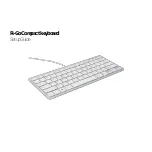
KARMA GE guide
956
Direct Index Group
Overview
Direct Index means to take a controller and map it into
the Note Series directly, so that notes can be directly
indexed and generated in real-time. One use is to take
an area of a keyboard and map it into the Note Series,
so that when you play the keys you are not generating
the true note, but are selecting notes from within the
Note Series. You can set up one area of the keyboard to
supply the input notes to the Note Series, and another
area to perform the Direct Indexing. This can allow
you to “solo” with musically correct notes, without
really thinking about what you are doing. Another use
is to take a controller like a Joystick and map it into the
Note Series, so that sweeping the controller sweeps
through the Note Series and generates glissandos and
flurries of notes. This can be done in addition to the
normal effect that the GE may be programmed to
generate.
Note that to perform Directing Indexing, a controller
must be selected as a
Source
in 7–7: Dynamic MIDI
page, and one of two different options selected as a
“Destination”:
• Direct Index
• DI & MdlStop (Direct Index & Module Stop)
For more information, see “Dynamic MIDI Sources &
Destinations” on page 984.
The parameters in this section affect the overall Direct
Indexing effect in general.
Index Shift
[0…3]
Selects one of several options for shifting the indexes
coming from the controller, if the Note Series at any
given time is longer than the range of the selected
controller. For example, if you specified an octave of
keys (12 keys) as a controller, and there were 24 notes
in the Note Series, those 12 potential indexes can be
directed to different areas of the Note Series.
If the number of steps in the range of the selected
controller is less than or equal to the number of notes
in the Note Series, this parameter has no effect and
KARMA automatically maps the indexes to the proper
notes. If the number of steps is equal, there will be a
predictable one-to-one correspondence between the
controller and the Direct Index notes. If there are fewer
notes in the Note Series than, KARMA automatically
maps the indexes in a way that prevents adjacent
controller indexes from selecting the same note. In
addition, in the case of using a CC to sweep through
the Note Series, values that would cause duplicate
notes will be filtered out. This means you can
comfortably use a CC with a range of
0–127
to sweep
through a 15 note Note Series.
0: Top
If the length of the Note Series is greater than the range
of the selected controller, the indexes will be shifted to
the top, so that the highest Direct Index note will be the
highest note in the Note Series.
1: Bottom
If the length of the Note Series is greater than the range
of the selected controller, the indexes will be shifted to
the bottom, so that the lowest Direct Index note will be
the lowest note in the Note Series.
2: Center
If the length of the Note Series is greater than the range
of the selected controller, the indexes will be centered
around the middle note of the Note Series.
3: Skip
If the length of the Note Series is greater than the range
of the selected controller, the indexes will be scaled
into the Note Series so that the lowest Direct Index
note will be the lowest note in the Note Series, the
highest Direct Index note will be the highest note in the
Note Series, and the other indexes will be spread out
over the Note Series, resulting in one or more notes in
the Note Series being skipped (cannot be indexed from
the controller).
Trill Mode
[0…5]
Selects one of several options for producing an
automatic randomized trill/arpeggio. When holding
down a certain number of Direct Index notes, an
automatic randomized trill/arpeggio can be produced.
The rate at which the notes are generated is
automatically calculated based on the tempo. This can
be used to simulate fast soloing riffs while performing
Direct Indexing.
0: Off/DynMIDI
No trill effect will be introduced, no matter how many
Direct Indexing notes are held down simultaneously.
1…5: 1 Note Or More…5 Notes Or More
Specifies the required number of notes that must be
held down before the trill/arpeggio starts. When set to
“
1 Note Or More
,” playing even a single note causes it
to start repeating at the automatically calculated rate.
Other notes may then be added to become part of the
trill/arpeggio.
0: Top
2: Center
1: Bottom
3: Skip
0: Off
3: 3 Note Or More
1: 1 Note Or More
4: 4 Notes Or More
2: 2 Notes Or More
5: 5 Notes Or More
Содержание Electronic Keyboard
Страница 1: ...Parameter Guide Parameter Guide ...
Страница 2: ......
Страница 180: ...Program mode EXi 170 ...
Страница 290: ...EXi STR 1 Plucked String 280 ...
Страница 572: ...Sequencer mode 562 ...
Страница 700: ...Global mode 690 ...
Страница 751: ...Insert Effects IFX1 IFX12 Routing 741 Fig 2 3a Fig 2 3b ...
Страница 902: ...Effect Guide 892 ...
















































